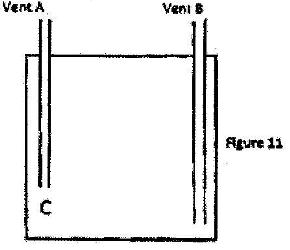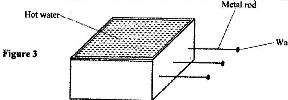Final reading = main scale reading + thimble scale reading
= 15. 00 + 0.30 = 15.30 mm, or 1.53 cm; or 1.53 x 10-2m
johnmulu answered the question on April 18, 2017 at 09:24
- Figure 2 shows a soft iron bar AB placed in a coil near a freely suspended magnet.(Solved)
Figure 2 shows a soft iron bar AB placed in a coil near a freely suspended magnet.

Explain the observation made when the switch is closed.
Date posted: April 18, 2017. Answers (1)
- Figure 2 shows a horse – shoe magnet whose poles are labeled and two other magnets near it. Iron nails are attracted to the lower ends of the magnets as shown.(Solved)
Figure 2 shows a horse – shoe magnet whose poles are labeled and two other magnets near it. Iron nails are attracted to the lower ends of the magnets as shown.

Identify the poles marked X and Y
Date posted: April 18, 2017. Answers (1)
- In the set up in Figure 17 the metal rod is made up of steel and iron pieces joined end to end. You are provided with two iron nails.(Solved)
In the set up in Figure 17 the metal rod is made up of steel and iron pieces joined end to end. You are provided with two iron nails.

Explain how you would use two nails provided to determine which side is iron
Date posted: April 18, 2017. Answers (1)
- Figure 7 shows how magnets are stored in pairs with keepers at the ends(Solved)
Figure 7 shows how magnets are stored in pairs with keepers at the ends. Explain how this method of storing helps in retaining magnetic longer

Date posted: April 18, 2017. Answers (1)
- In an experiment to magnetize two substances p and Q using electric currents, two curves (graphs) were obtained as shown in fig. 1(Solved)
In an experiment to magnetize two substances p and Q using electric currents, two curves (graphs) were obtained as shown in fig. 1

Using this information in Fig. 1 explain the difference between the substances P and Q with reference to the domain theory
Date posted: April 18, 2017. Answers (1)
- Figure 4 shows the cross-section of a dry cell. Use the information on the figure to answer question a) and b)(Solved)
Figure 4 shows the cross-section of a dry cell. Use the information on the figure to answer question a) and b)

a) Name the parts labeled A and B
b) State the use of manganese (IV) oxide in the cell.
Date posted: April 18, 2017. Answers (1)
- Figure 12, shows an electrical circuit including three switches, S1, S2, S3 and three identical lamps L1, L2, L3. A constant potential difference is applied across X and Y.(Solved)
Figure 12, shows an electrical circuit including three switches, S1, S2, S3 and three identical lamps L1, L2, L3. A constant potential difference is applied across X and Y.

i) Other than L1, state the lamp that will light when S1 and S2 are closed.
ii) How does the brightness in L1 in (i) above compare with its brightness when all the switches are closed?
iii) Explain the observation in (ii) above
Date posted: April 18, 2017. Answers (1)
- Figure 7 shows the features of a dry cell (Leclanche’s). Use the information in the figure to answer the questions a and b(Solved)
Figure 7 shows the features of a dry cell (Leclanche’s). Use the information in the figure to answer the questions a and b

a) State the polarities of the parts labeled A and B.
b) Name the chemical substance in the parts labeled C and D
Date posted: April 18, 2017. Answers (1)
- Figure 10 shows two circuits in which identical dry cells and identical bulbs are used. Use the information in the figure to answer questions 9 and 10.(Solved)
Figure 10 shows two circuits in which identical dry cells and identical bulbs are used. Use the information in the figure to answer questions a) and b)

a) Explain why the bulb in Figure 10 (b) will be brighter than each of the bulbs in Figure 10 (a).
b) Give the reason why the cells in Figure 10 (b) can be used for a longer period than the cells in Figure 10 (a).
Date posted: April 18, 2017. Answers (1)
- Figure 10 shows two circuits in which identical dry cells and identical bulbs are used. Use the information in the figure to answer questions a) and b)(Solved)
Figure 10 shows two circuits in which identical dry cells and identical bulbs are used. Use the information in the figure to answer questions a and b

a) Explain why the bulb in figure 10 (b) will be brighter than each of the bulbs in figure 10 (a).
b) Give the reason why the cells in figure 10 (b) can be used for a longer period than the cells in Figure (10a)
Date posted: April 17, 2017. Answers (1)
- In the circuit diagram shown in figure 12, the lamps are identical and the cells are also identical(Solved)
In the circuit diagram shown in figure 12, the lamps are identical and the cells are also identical

State with reason, in which circuit the lamp will be lit for a longer period
Date posted: April 17, 2017. Answers (1)
- Figure 7 shows a highly negatively charged rod being brought slowly near the cap of a positively charged leaf electroscope. If is observed that the leaf initially falls and then rises(Solved)
Figure 7 shows a highly negatively charged rod being brought slowly near the cap of a positively charged leaf electroscope. If is observed that the leaf initially falls and then rises

Explain this observation.
Date posted: April 17, 2017. Answers (1)
- Figure 6 shows a glass bath tube with water fitted with two identical thermometers A and B. It is heated as shown(Solved)
Figure 6 shows a glass bath tube with water fitted with two identical thermometers A and B. It is heated as shown

State with a reason which one of the two thermometers shows a higher temperature
Date posted: April 17, 2017. Answers (1)
- Figure 4 shows a source of heat placed at equal distances from two identical flasks X and Y containing air. The surface of X is painted black while Y is clear.(Solved)
Figure 4 shows a source of heat placed at equal distances from two identical flasks X and Y containing air. The surface of X is painted black while Y is clear.

X and Y are linked by a U-tube filled with whose levels S and T are initially the same. It is later observed that S falls while T rises. Explain this observation.
Date posted: April 17, 2017. Answers (1)
- Figure 3 shows a piece of wood fitted into copper pipe and a piece of a paper wrapped tightly around the junction.(Solved)
Figure 3 shows a piece of wood fitted into copper pipe and a piece of a paper wrapped tightly around the junction.

It is observed that when a flame is applied around the paper at the junction, the side of the paper around the wood burns first. Explain this observation.
Date posted: April 17, 2017. Answers (1)
- a) Figure 11 shows how an underground room was ventilated. It had two vents, one at A and the other at B. A fire was lit at point C.(Solved)
a) Figure 11 shows how an underground room was ventilated. It had two vents, one at A and the other at B. A fire was lit at point C.

Explain what happened to the ventilation when the fire was lit
b) Explain how a vacuum flask minimizes loss of heat through radiation.
Date posted: April 17, 2017. Answers (1)
- Figure 4 shows identical beakers P and Q full of water at 90oC. Two similar cold wet clothes are wrapped, one around the top of P and the other around the bottom of Q.
(Solved)
Figure 4 shows identical beakers P and Q full of water at 90oC. Two similar cold wet clothes are wrapped, one around the top of P and the other around the bottom of Q.

State with a reason the beaker in which the water cools faster.
Date posted: April 17, 2017. Answers (1)
- A paper windmill in a horizontal axis was placed above a candle as shown in Figure 2. When the candle was lit the paper windmill begun to rotate. Explain this observation(Solved)
A paper windmill in a horizontal axis was placed above a candle as shown in Figure 2. When the candle was lit the paper windmill begun to rotate. Explain this observation

Date posted: April 17, 2017. Answers (1)
- Use the following information to answer questions 17 and 18. Two identical empty metal containers P and Q are placed over(Solved)
Use the following information to answer questions a) and b)
Two identical empty metal containers P and Q are placed over identical Bunsen burners and the burners lit. P is dull black while Q is shiny bright. After each container attains a temperature of 100oC the burner are turned off. Identical test tubes containing water are suspended in each container without touching the sides as shown in Figure 3.

a) Explain why the container Q may become hot faster than P.
b) Explain why the water in test-tube in P becomes hot faster than in Q
Date posted: April 17, 2017. Answers (1)
- Figure 3 shows a hot water bath with metal rods inserted through one of its side. Some wax is fixed at the end of each rod. Use this information to answer questions
(Solved)
Figure 3 shows a hot water bath with metal rods inserted through one of its side. Some wax is fixed at the end of each rod. Use this information to answer questions

a) What property of metals could be tested using this set-up?
b) Besides the length of the rods that is kept constant, what else should be kept constant when comparing the property for the different metal rods?
Date posted: April 17, 2017. Answers (1)